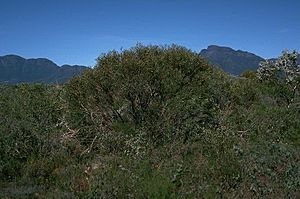Kalgan Plains mallee
Quick facts for kids Kalgan Plains mallee |
|
|---|---|
 |
|
| Eucalyptus pachyloma in the Stirling Range National Park | |
| Scientific classification | |
| Genus: |
Eucalyptus
|
| Species: |
pachyloma
|
The Kalgan Plains mallee (scientific name: Eucalyptus pachyloma) is a type of small eucalyptus tree that grows naturally in Western Australia. It has smooth, greyish bark. Its adult leaves are shaped like a spear. The tree produces groups of seven to thirteen flower buds. When they open, the flowers are white to cream-coloured. Later, it forms fruit that look like cones or cups.
What It Looks Like
This eucalyptus tree usually grows to be about 1 to 4 metres (3 to 13 feet) tall. It has smooth bark that can be grey-brown or green. At its base, it forms a special woody swelling called a lignotuber. This helps the plant regrow after a fire.
The leaves are glossy green and stand upright. They are arranged alternately along the stem. Each leaf is typically shaped like a spearhead, about 5.8 to 10.8 centimetres (2.3 to 4.3 inches) long and 0.7 to 1.8 centimetres (0.3 to 0.7 inches) wide. The tip of the leaf is pointed, and the base narrows down to a stalk called a petiole.
The Kalgan Plains mallee blooms between October and March. Its flowers are white to cream-coloured. The flowers grow in groups called umbels, with seven to thirteen buds in each group. These buds are oval or round, about 0.7 to 1.0 centimetre (0.3 to 0.4 inches) long and 0.6 to 0.9 centimetre (0.2 to 0.4 inches) wide. They have a single cap, called an operculum, which is cone-shaped or rounded.
After the flowers, the tree forms fruit. These fruits are broadly cup-shaped or cone-shaped. They are about 0.7 to 1.1 centimetres (0.3 to 0.4 inches) long and 1.2 to 1.7 centimetres (0.5 to 0.7 inches) wide. Inside, the brown seeds are shaped like pyramids or half-circles, and they are about 2.5 to 3.5 millimetres (0.10 to 0.14 inches) long.
Its Scientific Name and Family
The scientific name Eucalyptus pachyloma was first officially described by a botanist named George Bentham in 1867. He wrote about it in a book called Flora Australiensis.
The name pachyloma comes from two Greek words. Pachy means thick, and loma means border. This name refers to the thick rim found on the fruit of this plant.
This species belongs to a special group of Eucalyptus trees called the Diversiformae series. All the mallees in this group have adult leaves that stand upright. Their flower buds have a single cap that doesn't leave a scar when it falls off. They also have pyramid-shaped seeds. Other species in this group include the Stirling Range mallee and the Jimberlana mallee.
Where It Grows
The Kalgan Plains mallee is found in the southern parts of Western Australia. It grows on sandy plains and foothills. You can find it in the Wheatbelt and Great Southern regions. Its range stretches from Pingelly in the north down to Albany in the south.
Is It Safe?
The Western Australian Government's Department of Parks and Wildlife has classified this eucalypt as "not threatened." This means it is not currently at risk of disappearing.

